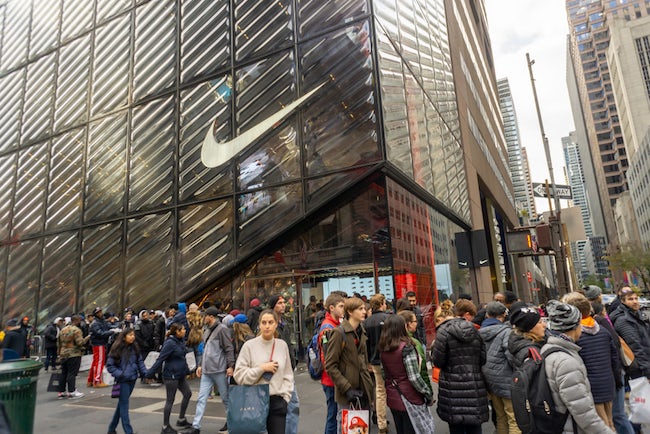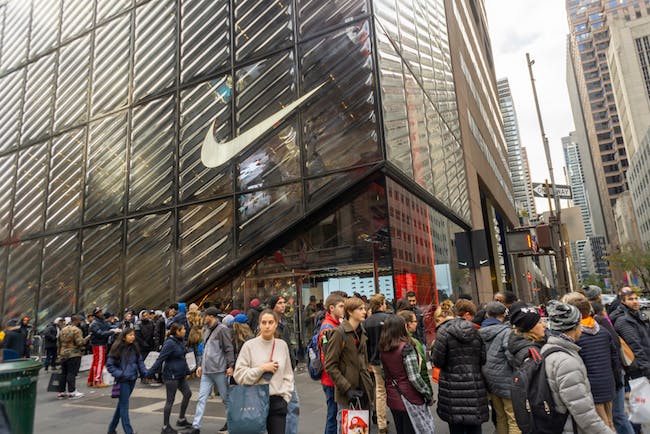In January of this year, Westfield’s ‘How We Shop’ report predicted that, by 2025, more than half of all retail space will be devoted to experience rather than product.
A separate study by Epson found that 75% of surveyed respondents would choose in-store shopping if retail outlets provided a more immersive experience.
In the space of just a few months, this ideal has been turned on its head. Due to the coronavirus pandemic, more and more consumers have turned to online shopping, with industry figures now suggesting that this behaviour might become a permanent habit. Now, as stores start to re-open after lockdown, retailers are finding ways to speed up the in-store experience, ideally making it as fast, efficient, and as safe as possible. The idea of getting shoppers to linger is simply not on the agenda right now.
But with experiential previously predicted to be the saviour of brick-and-mortar retail, what does this mean for the industry as a whole, as well as the brands that have already invested big in the strategy?

Retail focused on efficiency, not entertainment
Towards the end of 2018 through to the beginning of 2020, experiential grew as a retail strategy. Alongside conceptual stores from established brands like Nike and Vans, we also saw direct-to-consumer favourites including Glossier, Allbirds, and Casper open permanent brick-and-mortar locations. From in-store events to conceptual design, these stores are characterised by the immersive and inspiring experience they offer shoppers, which goes far beyond basic transactions.
The ‘House of Vans’ in London, for example, is a 30,000 square feet space complete with its own cinema, art gallery, and collection of skate ramps. It allows visitors to socialise as well as shop, enabling the brand to become part of consumers’ lifestyle rather than merely an item of footwear.
As well as the long-term impact of this kind of retail experience, it can also have a profitable impact on short-term sales, too. In short, the idea is that consumers are likely to spend more money, the more time they spend in-store.
Due to the coronavirus pandemic, most retailers have cancelled all events and experiential activities for the foreseeable future. Upon re-opening, under government regulations, retailers will be required to take precautions in order to ensure social distancing and implement safety measures for customers and staff.
This is likely to include limited entry, one-way systems, and perhaps even the continued closure of event spaces. It doesn’t exactly align with the idea of ‘social shopping’.
Indeed, for many retailers who previously offered immersive (and highly social) retail experiences, the future is going to be different for the next few months at least. Some sectors are likely to be impacted more than others, of course. The beauty industry, for instance, will be unable to deliver the kind of services that previously drew in consumers, including product sampling and beauty consultations.
The level of impact also depends on how stores are designed, too. Large spaces, perhaps where the focus is more on digital technology rather than a large number of products, will be better equipped for social distancing, where a limited number of customers are allowed inside at one time. Allbirds’ physical retail store is an example that spring to mind here; its minimal layout (and limited number of shoes on display) is designed to bring design and the brand into focus.
Brands forced to hold back on brick-and-mortar
What experiential retail will actually look like for the foreseeable future remains unclear, and even some of the biggest names in the industry are uncertain about how or when things will return to normal.
In a recent blog post, Glossier’s founder and CEO, Emily Weiss stated: “The very things that make Glossier retail so special – the crowds, the lines, the experience of being together – are also the reasons why we have an added responsibility to our community. We’re challenging ourselves to reimagine the offline experience for this moment and beyond, and we’re hard at work finding new ways to inspire joy and bring people together, safely.”
As a result of continued closures, Glossier has taken the decision to furlough its staff in New York, Los Angeles and London, covering benefits until August. Up until the end of May, staff were being paid full wages.
Weiss has stated that Glossier is likely to be one of the last retail stores to re-open, and we could see other experiential-led retailers follow suit and hold back on brick-and-mortar for the time being at least. With the lion’s share of Glossier’s sales coming from ecommerce, this isn’t disastrous. Moreover, a certain amount of hesitance could actually work in its favour, with the public perhaps looking more favourably on brands that put the safety and experience of customers before business gain.
Retailers taking a different route for experiential
For brands that do re-open soon, the focus is likely to shift away from encouraging customers to spend lots of time in-store to instead making the experience as quick and easy as possible.
This doesn’t necessarily mean experiential elements will vanish, but rather, adapted so that services remain contactless (and largely digital, where possible).
Beauty brands are likely to continue pushing virtual beauty consultations in order to reduce deliberation during store visits; a number of brands including Clarins, Glossier, and Huda Beauty have shifted to this activity throughout the coronavirus pandemic. In some ways, this also aligns with how in-store beauty retail might evolve, with one-to-one or appointment-only consultations becoming the norm.
Alongside functional services, we could also see brands continue with virtual events, which also serve to replicate the more social and interactive side of experiential retail. Forbes states that Hatch, a US maternity brand, has replaced its in-store meet-ups with digital ones, enabling customers to continue getting involved in community events.
It’s not just a case of replicating experiential events online; other retailers have also seen an opportunity to increase activity in this area, ramping up virtual events during the pandemic. John Lewis is one example; the retailer has enabled customers to partake in a range of ‘entertaining and virtual experiences’ such as wine tasting or beauty demonstrations online, which it doesn’t always offer year-round.
Another avenue that we might see retailers explore is outdoor events, set up in spaces that are better suited to social distancing and general safety. This is already a popular strategy within experiential marketing, with brands typically appearing at big festivals and sporting events. With the majority of large seasonal events this summer already cancelled, however, we could see more retail brands getting involved in smaller-scale activations and sponsored events, such as outdoor movie screenings or socially distanced pop-ups.
In terms of stores themselves, it is likely that retailers will prioritise more functional (and transactional) elements of the shopping experience for the time being. It’s perhaps overly negative to suggest that experiential retail will be on the back-burner long-term, though of course most retailers will be immediately focused on generating online sales, before opening stores with safety in mind. Due to the unprecedented impact of Covid-19, however, it’s sure to take retailers a little longer to re-create the same experiences – with the same level of consumer enthusiasm – as previously seen.




